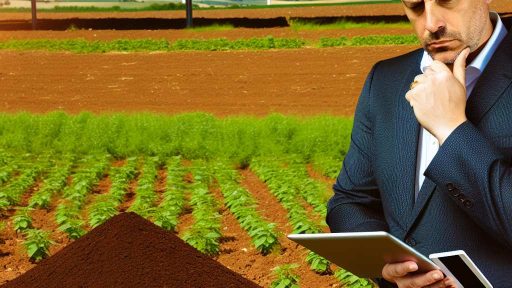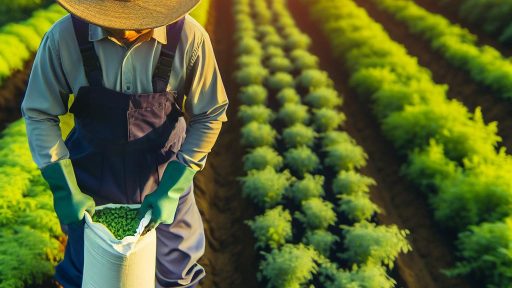Introduction to Agricultural Weeds and Their Impact on Land Value
Agricultural weeds pose a significant threat to land value.
These unwanted plants compete with crops for vital resources.
As a result, they hinder agricultural productivity.
Farmers often face increased costs dealing with infestations.
Furthermore, weed control measures can be labor-intensive and expensive.
Invasive species tend to have a more pronounced effect on land value.
Persistent weeds can lead to lower yields and reduced profits.
Ultimately, this results in a decrease in overall land value.
Addressing weed issues promptly is crucial for maintaining land worth.
Farmers must understand which weeds are prevalent in their regions.
Each weed type can have unique characteristics and control methods.
In this context, knowledge and preparation become vital for success.
Next, we will explore the most common weed types affecting agricultural land.
Overview of Common Weed Types Found in Agricultural Fields
Introduction to Weeds
Weeds are unwanted plants that interfere with agricultural productivity.
They compete for nutrients, light, and water.
Transform Your Agribusiness
Unlock your farm's potential with expert advice tailored to your needs. Get actionable steps that drive real results.
Get StartedUnderstanding these plants is crucial for effective management.
Types of Common Weeds
Several common weed types affect agricultural fields.
Each type presents unique challenges for farmers.
Annual Weeds
Annual weeds complete their life cycle in one year.
Examples include crabgrass and foxtail.
These weeds thrive in disturbed soil and can quickly dominate fields.
Perennial Weeds
Perennial weeds can live for multiple years.
Dandelion and thistle are prominent examples.
These weeds often spread through rhizomes or seeds, complicating control efforts.
Biennial Weeds
Biennial weeds take two years to complete their life cycle.
Common species include burdock and foxglove.
They typically grow vegetatively in the first year and flower in the second.
Impact on Agricultural Land Value
Weeds significantly affect agricultural land value.
They decrease crop yields and increase management costs.
Farmers must invest in weed control measures to maintain productivity.
Weed Management Strategies
Effective weed management requires a proactive approach.
Crop rotation, cover crops, and herbicides are commonly used methods.
Farmers should also monitor fields regularly for emerging weeds.
Economic Impact of Weeds on Crop Yields and Profits
Understanding Weed Competition
Weeds compete with crops for essential resources.
These resources include water, nutrients, and light.
Consequently, weeds can lead to reduced crop yields.
Crops suffering from this competition yield less produce.
Furthermore, lower yields often translate to reduced profits.
Effects on Crop Quality
Weeds also affect the quality of agricultural produce.
Showcase Your Farming Business
Publish your professional farming services profile on our blog for a one-time fee of $200 and reach a dedicated audience of farmers and agribusiness owners.
Publish Your ProfileCompetition can lead to smaller or less flavorful crops.
In turn, this diminished quality may decrease market prices.
Farmers may struggle to sell low-quality harvests.
Consequently, they face potential financial losses.
Cost of Weed Management
Managing weeds incurs significant operational costs.
These costs include herbicides, labor, and equipment.
Farmers must regularly invest in effective weed control.
Failure to control weeds can compound these expenses.
In the long run, this may hinder overall profitability.
Long-term Land Value Implications
Persistent weed problems can lower land value over time.
Potential buyers often assess a farm’s weed history.
Land with significant weed issues appears less desirable.
This perception can affect resale opportunities.
Farmers must thus be vigilant in managing their fields.
Case Studies and Research Findings
Research highlights the financial impact of weeds globally.
A study from the Midwest shows significant yield losses due to weeds.
Moreover, specific weed species can drastically affect profits.
For instance, Palmer amaranth has proven particularly problematic.
Farmers implementing robust weed management systems often see improved profitability.
Enhancing Yields through Strategic Management
Weeds present a substantial economic challenge to farmers.
Addressing weed issues proactively can significantly enhance yields.
Farmers should invest in effective weed management solutions.
Doing so ensures their land remains valuable and productive.
Learn More: Choosing the Right Irrigation System for Farming Landowners
Strategies for Identifying and Classifying Weeds
Recognizing Common Weed Species
Weeds often resemble cultivated plants, making identification challenging.
Start by becoming familiar with local weed species.
Field guides can be valuable resources for identification.
Understanding their growth habits aids in differentiation.
Utilizing Visual Characteristics
Observe the overall structure of the plants.
Note leaf shape, size, and arrangement on the stem.
Additionally, look at flower colors and patterns.
These traits provide clues to proper classification.
Identifying Growth Habitats
Weeds thrive in specific environments, which can aid identification.
Recognize that some prefer disturbed soils, while others flourish in moist areas.
Understanding these preferences can narrow down possibilities.
Leveraging Technology and Tools
Many apps assist in identifying plant species quickly.
Use smartphone applications to enhance your identification skills.
Digital databases often contain images and descriptions for comparison.
Moreover, social media groups can offer additional expertise.
Monitoring Growth Stages
Identify weeds by observing their growth stages throughout the season.
Showcase Your Farming Business
Publish your professional farming services profile on our blog for a one-time fee of $200 and reach a dedicated audience of farmers and agribusiness owners.
Publish Your ProfileSeedlings appear different from mature plants, so take note.
Understanding these stages helps in classification and management.
Documenting Findings
Create a weed management journal to track species and locations.
Record observations about density and behavior over time.
This helps in recognizing trends and managing infestations effectively.
Delve into the Subject: Improving Soil Fertility Through Proper Fertilizer Management
The Role of Weeds in Soil Health and Crop Competition
Understanding Weeds
Weeds play a significant role in agricultural systems.
They can affect soil health and crop productivity.
Farmers often struggle with controlling these invasive plants.
Understanding their impact is essential for effective management.
Impact on Soil Health
Weeds can both positively and negatively influence soil conditions.
On one hand, some weeds improve soil structure.
They contribute organic matter when decomposed.
Additionally, they can prevent soil erosion.
However, many weeds deplete nutrients essential for crops.
For instance, deep-rooted weeds compete for water and minerals.
This competition can reduce crop yields significantly.
Crop Competition Dynamics
Weeds are fierce competitors in agricultural fields.
They vie for light, water, and nutrients with crops.
Fast-growing weeds can overshadow young plants.
This shading effect hampers crop growth and development.
Furthermore, explosive weed proliferation can decrease crop density.
Ultimately, this competition can lead to financial losses.
Management Strategies
Effective weed management is crucial for maintaining productivity.
Farmers often use a combination of methods to control weeds.
- Mechanical methods include tilling and mowing.
- Chemical methods involve herbicides designed to target specific weeds.
- Crop rotation helps break weed life cycles.
- Cover cropping can suppress weed growth.
Integrating these strategies can help optimize crop yields.
Significance of Weed Awareness
Weeds have a profound impact on agriculture.
They affect both soil health and crop competition.
Awareness of their role is vital for sustainable farming practices.
Continuous research and adaptive management are essential.
Uncover the Details: Maximizing Crop Yields With Strategic Harvesting In Rural Real Estate Ventures

Cultural Practices to Manage and Control Weeds
Understanding the Role of Cultural Practices
Cultural practices play a vital role in effective weed management.
They involve modifying farming systems to reduce weed pressure.
Using these practices can enhance crop competitiveness against weeds.
Moreover, they contribute to sustainable agricultural systems.
Crop Rotation
Crop rotation disrupts the life cycles of weeds.
By changing crops, farmers can minimize weed populations.
Diverse crops prevent specific weeds from establishing dominance.
Additionally, some crops can suppress weed growth through shading.
Cover Cropping
Cover crops provide multiple benefits for weed management.
Showcase Your Farming Business
Publish your professional farming services profile on our blog for a one-time fee of $200 and reach a dedicated audience of farmers and agribusiness owners.
Publish Your ProfileThey cover soil during the off-season, reducing weed establishment.
Furthermore, they enhance soil structure and fertility.
When chosen wisely, cover crops can outcompete weeds.
Soil Health Management
Healthy soil promotes vigorous crop growth, limiting weed encroachment.
Improving soil fertility boosts crop yields and resilience.
Practices like composting enhance organic matter in the soil.
Additionally, reducing soil disturbance can protect beneficial organisms.
Proper Irrigation and Fertilization
Efficient irrigation can limit weed growth by managing moisture levels.
Targeting specific crop needs helps prevent excess nutrients.
Over-fertilizing can promote weed growth alongside crops.
Thus, balanced fertilization is crucial for weed control.
Mowing and Tillage
Mowing can effectively manage weeds in certain crops.
It reduces seed production and softens competition.
Tillage helps control weeds by disrupting their growth cycle.
However, over-tillage can lead to soil erosion and compaction.
Cultural Weed Suppression Strategies
Utilizing mulching can block light from reaching weed seeds.
Organic mulches add nutrients while suppressing weed growth.
A strong plant canopy also inhibits weeds naturally.
Additionally, timed planting can outpace weed emergence.
Discover More: Conservation Tillage Systems for Improving Water Retention
The Importance of Integrated Weed Management in Sustaining Land Value
Understanding Integrated Weed Management
Integrated Weed Management (IWM) combines various strategies to control weeds.
This approach enhances agricultural productivity over time.
Farmers implement cultural, mechanical, and chemical control methods.
Each method works together to minimize reliance on herbicides.
Economic Implications of Weeds
Weeds can significantly reduce crop yields.
They also can lower the overall value of agricultural land.
High weed populations often lead to increased management costs.
Farmers bear additional economic burdens due to lost production.
Long-term Sustainability
Effective IWM practices contribute to sustainable agriculture.
They help preserve the environment by reducing chemical usage.
Sustainable farming practices enhance soil health and biodiversity.
As a result, agricultural land retains its value over time.
Practical Strategies for IWM
Farmers can adopt various tactics to implement IWM effectively.
- Crop rotation disrupts weed growth cycles.
- Cover crops suppress weed development between seasons.
- Proper tillage practices can reduce weed seed banks in the soil.
- Regular monitoring helps identify weed species and density.
By employing these strategies, farmers can maintain crop health and land value.
Collaboration and Education
Farmers should collaborate with agronomists and extension services.
Workshops and training can improve knowledge of weed management.
Sharing successful IWM practices enhances the entire agricultural community.
Education empowers farmers to make informed decisions regarding weed control.
Implications of Integrated Weed Management
Integrated Weed Management is essential for sustaining agricultural land value.
Through strategic planning and community support, farmers can thrive.
Showcase Your Farming Business
Publish your professional farming services profile on our blog for a one-time fee of $200 and reach a dedicated audience of farmers and agribusiness owners.
Publish Your ProfileThe benefits of IWM extend beyond immediate profits; they foster long-term soil and land health.
Case Studies on Weeds Negatively Affecting Agricultural Land Values
Impact of Glyphosate-Resistant Weeds
The rise of glyphosate-resistant weeds poses a significant threat to crop production.
Farmers increasingly face economic losses due to these persistent invaders.
For instance, in the Midwest, Palmer amaranth has become a serious issue.
This weed reduces soybean yields dramatically, impacting profitability.
Case studies show that management costs for affected farms can increase significantly.
Ultimately, these financial pressures can decrease overall land value.
Stinging Nettle as an Agricultural Challenge
Stinging nettle grows rapidly and competes for nutrients in crops.
Farmers often report reduced crop health and productivity due to its presence.
A case from Washington state illustrates how nettle invaded local fields.
This resulted in substantial yield reductions and increased management costs.
Consequently, landowners found it challenging to sell or lease their properties.
Economic Effect of Johnson Grass
Johnson grass infests fields, driving up production costs for farmers.
This invasive plant can significantly lower corn and wheat yields.
A study in Texas highlighted the herbicide expenses required for control.
Farmers in this region experienced reduced land valuations due to ongoing infestations.
Moreover, land appraisers often factor in weed control costs when assessing value.
Control Measures and Their Effectiveness
Effective management strategies can mitigate the impacts of these weeds.
Integrated approaches often prove successful in controlling weed populations.
For example, crop rotation and cover cropping enhance soil competition.
However, the initial investment in these strategies can deter some farmers.
Ultimately, proactive measures lead to healthier crops and sustained land values.
Additional Resources
Researchers Helping Protect Crops From Pests | NIFA
Land Transitions and Dust in the San Joaquin Valley – Public Policy …




